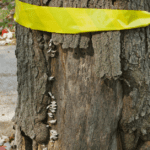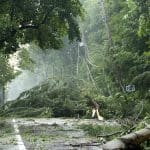
Spring is lauded for blooming flowers, but it has a downside, too. As the weather warms, insects proliferate while bacteria and viruses can flourish. Spring rains make fungi, well, mushroom, and the season’s lovely breezes spread the fungi spores.
So you’re more apt to encounter tree diseases in spring. Early identification can mitigate damage to the tree and help contain the spread of the disease to surrounding vegetation. To spot potential issues, monitor these areas:
Bark
Check for pitting, holes, significant cracks, bark peeling up, or splits beyond the outer layer, and note mushrooms or other fungi growing on the trunk. Early-stage aspen canker can manifest as sunken oval areas in the bark that later worsens to crumbling bark.
Black streaks on elm wood under the bark is a sign of the highly destructive Dutch Elm disease. Flaky bark or holes in ash trees might signify emerald ash borer. Sour-smelling fluid oozing through an old crack or hole is a sign of alcoholic slime flux in a shade tree.
Roots
A leaning trunk, loosening of the tree’s hold on the soil, or changes in the soil, such as oversaturation, can spell trouble. For instance, honey locusts subjected to constantly wet soil can be vulnerable to cankers above areas previously killed by root collar rot.
Also, check for fungi near any tree’s roots. Light-colored mushrooms, for example, may grow near the base of an oak infected with Armillaria root rot.
Branches
If live insects aren’t visible, burrow trails can be evidence of their presence. Also, watch for abnormal growths, such as galls on juniper or cedar twigs, which may be the first sign of cedar-apple rust. Flowering sprouts on dogwood branches indicate anthracnose and a spindle-shaped gall on a pine branch is a symptom of fusiform rust.
Swollen, discolored branches of trees such as cherries and plums can be an early sign of black knot. Small white bumps on the branches of shade trees might be sap-sucking insects rather than growth formations; this is known as tree scale. Dying branches can also be telling; for instance, branch dieback in cypress trees is one of the early signs of Seiridium canker.
Foliage
Watch for discoloration, splotches or spots, yellow new leaves, premature defoliation, or leaves that are browning, curling or tattering. Signs of anthracnose in shade trees such as oak, ash, sycamore and maple include dropping of seemingly healthy leaves, blackness and withering of younger leaves, or browning leaves along the veins.
Defoliation on junipers, apples or crabapples can indicate cedar-apple rust, while rust diseases on pear or apple trees can manifest early on as small yellow-orange spots on the leaves. Light green or yellow-green spots appearing in late spring on maple or sycamore leaves could be tar spot, but leaf spot also causes spots of various shapes, sizes and colors, depending on the host.
An early sign of Dutch Elm disease is yellowing and curling leaves. Small brown to olive green spots on apple or crabapple trees can indicate apple scab. On oaks, dull green or bronze leaves or blotchy leaves can signal oak wilt, which must be addressed quickly to save the tree. Lesions on pine needles can indicate brown spot needle blight or needle cast.
Growth
If spring leaves or blooms seem to be growing too slowly, growing inconsistently, or not growing at all, the tree could be diseased. An early sign of fire blight on hawthorns, apples, pears and mountain-ash is darkening and shriveling flowers.
Browned edges of new hackberry or oak leaves could be an early sign of leaf tatter; leaves may then pucker and develop a lacy appearance. On stone and pome fruit trees, browning flower petals leading to shriveled flowers remaining on the twig is an early sign of brown rot.
Fruit
Note any irregularities in a tree’s fruit. Gray or brown fuzz on peaches or apricots, for instance, can indicate brown rot. Apple scab can make the apples or crabapples become misshapen or cracked.
The diseases mentioned here are just a few examples. It’s important to note that various diseases can present similar symptoms, so unless you have a certified arborist on staff who is sure of a diagnosis, it’s best to consult an arborist to identify the specific disease before determining a course of treatment.




